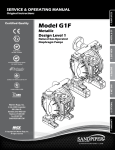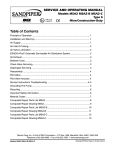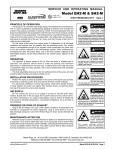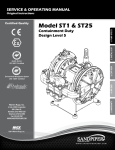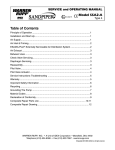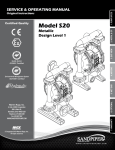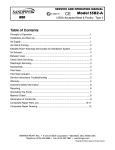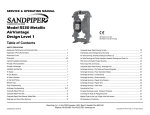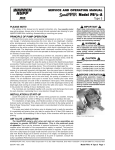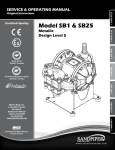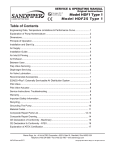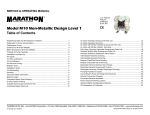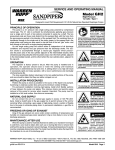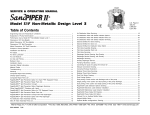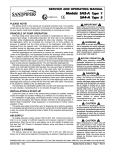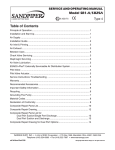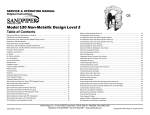Download PDF
Transcript
SERVICE & OPERATING MANUAL Original Instructions Certified Quality Model ST1½ & ST40 2: INSTAL & OP 1: PUMP SPECS Containment Duty Design Level 4 3: EXP VIEW Quality System ISO 9001 Certified 5: WARRANTY 4: AIR END Environmental Management System ISO 14001 Certified Warren Rupp, Inc. A Unit of IDEX Corporation 800 N. Main St., Mansfield, Ohio 44902 USA Telephone (419) 524.8388 Fax (419) 522.7867 WWW.SANDPIPERPUMP.COM ©2015 Warren Rupp, Inc. www.sandpiperpump.com Safety Information IMPORTANT WARNING When used for toxic or aggressive fluids, the pump should always be flushed clean prior to disassembly. Read the safety warnings and instructions in this manual before pump installation and start-up. Failure to comply with the recommendations stated in this manual could damage the pump and void factory warranty. Before maintenance or repair, shut off the compressed air line, bleed the pressure, and disconnect the air line from the pump. Be certain that approved eye protection and protective clothing are worn at all times. Failure to follow these recommendations may result in serious injury or death. When the pump is used for materials that tend to settle out or solidify, the pump should be flushed after each use to prevent damage. In freezing temperatures the pump should be completely drained between uses. Airborne particles and loud noise hazards. Wear eye and ear protection. CAUTION In the event of diaphragm rupture, pumped material may enter the air end of the pump, and be discharged into the atmosphere. If pumping a product that is hazardous or toxic, the air exhaust must be piped to an appropriate area for safe containment. Before pump operation, inspect all fasteners for loosening caused by gasket creep. Retighten loose fasteners to prevent leakage. Follow recommended torques stated in this manual. Take action to prevent static sparking. Fire or explosion can result, especially when handling flammable liquids. The pump, piping, valves, containers and other miscellaneous equipment must be properly grounded. Nonmetallic pumps and plastic components are not UV stabilized. Ultraviolet radiation can damage these parts and negatively affect material properties. Do not expose to UV light for extended periods of time. This pump is pressurized internally with air pressure during operation. Make certain that all fasteners are in good condition and are reinstalled properly during reassembly. WARNING Pump not designed, tested or certified to be powered by compressed natural gas. Powering the pump with natural gas will void the warranty. Use safe practices when lifting kg Grounding ATEX Pumps ATEX compliant pumps are suitable for use in explosive atmospheres when the equipment is properly grounded in accordance with local electrical codes. Pumps equipped with electrically conductive diaphragms are suitable for the transfer of conductive or non-conductive fluids of any explosion group. When operating pumps equipped with non-conductive diaphragms that exceed the maximum permissible projected area, as defined in EN 13461-1: 2009 section 6.7.5 table 9, the following protection methods must be applied: • Equipment is always used to transfer electrically conductive fluids or • Explosive environment is prevented from entering the internal portions of the pump, i.e. dry running For further guidance on ATEX applications, please consult the factory. Model ST1½/ST40 www . sandpiperpump . com st15dl4sm-rev0915 1: PUMP SPECS Table of Contents 2: INSTAL & OP SECTION 1: PUMP SPECIFICATIONS.................1 • Explanation of Nomenclature • Performance • Materials • Dimensional Drawings 3: EXP VIEW SECTION 2: INSTALLATION & OPERATION.......4 • Principle of Pump Operation • Recommended Installation Guide • Filling the Driver Chambers with Fluid • Troubleshooting Guide SECTION 3: EXPLODED VIEW............................8 • Composite Repair Parts Drawing • Composite Repair Parts List • Material Codes 4: AIR END SECTION 4: AIR END........................................11 • Air Valve with Stroke Indicator Assembly • Pilot Valve Assembly www . sandpiperpump . com st15dl4sm-rev0915 5: WARRANTY SECTION 5: WARRANTY & CERTIFICATES.....13 • Warranty • CE Declaration of Conformity - Machinery • ATEX Declaration of Conformity Model ST1½/ST40 1: PUMP SPECS Explanation of Pump Nomenclature Your Model #: (fill in from pump nameplate) __ _________ ___ __ __ Pump Series Pump Design Pump Size Discharge Diaphragm/ and Options Porting Valve Design Level Construction Model #: XXX XXXXXX, XX XXXXXX Pump Series SSANDPIPER HDF1 Pump Design T Diaphragm Check Valve Materials ® Spill Containment ATEX Detail Pump Size & Options 1½"NPT II 1G c T5 40 1½" BSP Tapered GI EPDM Driver Diaphragms, PTFE Pumping Diaphragms, and PTFE Check Balls NG Neoprene Driver Diaphragms, PTFE Pumping Diaphragms, andConstruction PTFE Check Balls VG FKM Driver Diaphragms, PTFE Pumping Diaphragms, and PTFE Check Balls II 1D c T100°C I M1 c Visual Leak Detection Sight Tubes I M2 c Options VL II, SI, HI Design Level 4 Construction A Aluminum Wetted, Aluminum Air Options CI Cast Iron Wetted, Aluminum Air II Cast Iron Wetted, Cast Iron Air SI Stainless Steel Wetted, Cast Iron Air SS Stainless Steel Wetted, Aluminum Air 00 HC Alloy-C Wetted, Aluminum Air HI Alloy-C Wetted, Cast Iron Air Discharge Porting Position S Side II 2G c T5 II 2D c T100°C A, HC, I, SI, SS 00 A, HC, HI, I, II, SI, SS P1 Construction Options II 1G c T5 II 1D c T100°C I M1 c I M2 c II, SI, HI N/A II 2G c T5 II 2D c T100°C A, CI, II, HI, HC, SI, SS N/A Construction Options II 1G c T5 II 1D c T100°C I M1 c I M2 c SI, HI 00 II 2G c T5 II 2D c T100°C A, SI, SS, HC, HI 00 II 2G Ex ia c IIC T5 II 2D Ex c iaD 20 IP67 T100°C A, HC, HI, SI, SS P1 II 2G Ex ia c IIC T5 II 2D Ex c iaD 20 IP67 T100°C ATEX Detail HDB1½, ST1½ ATEX Detail HDB2, SB1, SA1 1 • Model ST1½/ST40 ATEX Detail www . sandpiperpump . com st15dl4sm-rev0915 Performance 7 CAPACITY • 0 to 90 gallons per minute (0 to 340 liters per minute) PSI BAR SUCTION/DISCHARGE PORT SIZE • ST1½: 1½ (37.5mm) NPT (F) • ST40: 1½ (37.5MM) BSP (F)(Tapered) 100 6 5 HEAD AIR DISTRIBUTION VALVE • No-lube, no-stall design 4 SOLIDS-HANDLING • Occasional solids only. Up to ¼ in. (6.3mm) 3 HEADS UP TO • 125 psi or 289 ft. of water (8.8 Kg/cm2 or 88 meters) 2 MAXIMUM OPERATING PRESSURE • 125 psi (8.6 bar) DISPLACEMENT/STROKE • .37 Gallon / 1.29 liter 1 90 80 PSI 70 60 PSI 50 90(152.9) 40 40 PSI 30 20 20 PSI Air Inle t Pressure 10 SHIPPING WEIGHT • Aluminum 99 lbs. (46kg) • Cast Iron 146 lbs. (66kg) • Stainless Steel 212 lbs. (95kg) 70(119) 80(136) 60 0 Performance based on the following: elastomer fitted pump, flooded suction, water at ambient conditions. The use of other materials and varying hydraulic conditions may result in deviations in excess of 5%. 60(102) 80 0 MODEL ST1½/ST40 Performance Curve AIR CONSUMPTION SCFM (M3/hr) 10(17) 20(34) 30(51) 40(68) 100 P SI 50(85) 0 10 0 20 50 30 40 50 60 70 US Gallons per minute 100 150 200 Liters per minute CAPACITY 250 80 300 90 350 Materials Material Profile: Operating Temperatures: Polypropylene: A thermoplastic polymer. Moderate tensile and flex strength. Resists stong acids and alkali. Attacked by chlorine, fuming nitric acid and other strong oxidizing agents. 180°F 82°C 32°F 0°C PVDF: (Polyvinylidene Fluoride) A durable fluoroplastic with excellent chemical resistance. Excellent for UV applications. High tensile strength and impact resistance. 250°F 121°C 0°F -18°C Santoprene®: Injection molded thermoplastic elastomer with no fabric layer. Long mechanical flex life. Excellent abrasion resistance. 275°F 135°C -40°F -40°C UHMW PE: A thermoplastic that is highly resistant to a broad range of chemicals. Exhibits outstanding abrasion and impact resistance, along with environmental stress-cracking resistance. 180°F 82°C -35°F -37°C Urethane: Shows good resistance to abrasives. Has poor resistance to most solvents and oils. 150°F 66°C 32°F 0°C Virgin PTFE: (PFA/TFE) Chemically inert, virtually impervious. Very few chemicals are known to chemically react with PTFE; molten alkali metals, turbulent liquid or gaseous fluorine and a few fluoro-chemicals such as chlorine trifluoride or oxygen difluoride which readily liberate free fluorine at elevated temperatures. 220°F 104°C -35°F -37°C CAUTION! Operating temperature limitations are as follows: Max. Min. Conductive Acetal: Tough, impact resistant, ductile. Good abrasion resistance and low friction surface. Generally inert, with good chemical resistance except for strong acids and oxidizing agents. 190°F 88°C -20°F -29°C EPDM: Shows very good water and chemical resistance. Has poor resistance to oils and solvents, but is fair in ketones and alcohols. 280°F 138°C -40°F -40°C FKM: (Fluorocarbon) Shows good resistance to a wide range of oils and solvents; especially all aliphatic, aromatic and halogenated hydrocarbons, acids, animal and vegetable oils. Hot water or hot aqueous solutions (over 70°F(21°C)) will attack FKM. 350°F 177°C -40°F -40°C Hytrel®: Good on acids, bases, amines and glycols at room temperatures only. 220°F 104°C -20°F -29°C Neoprene: All purpose. Resistance to vegetable oils. Generally not affected by moderate chemicals, fats, greases and many oils and solvents. Generally attacked by strong oxidizing acids, ketones, esters and nitro hydrocarbons and chlorinated aromatic hydrocarbons. 200°F 93°C -10°F -23°C Nitrile: General purpose, oil-resistant. Shows good solvent, oil, water and hydraulic fluid resistance. Should not be used with highly polar solvents like acetone and MEK, ozone, chlorinated hydrocarbons and nitro hydrocarbons. 190°F 88°C -10°F -23°C Metals: Nylon: 6/6 High strength and toughness over a wide temperature range. Moderate to good resistance to fuels, oils and chemicals. 180°F 82°C 32°F 0°C Stainless Steel: Equal to or exceeding ASTM specification A743 CF-8M for corrosion resistant iron chromium, iron chromium nickel and nickel based alloy castings for general applications. Commonly referred to as 316 Stainless Steel in the pump industry. Maximum and Minimum Temperatures are the limits for which these materials can be operated. Temperatures coupled with pressure affect the longevity of diaphragm pump components. Maximum life should not be expected at the extreme limits of the temperature ranges. Alloy C: Equal to ASTM494 CW-12M-1 specification for nickel and nickel alloy. For specific applications, always consult the Chemical Resistance Chart. Ambient temperature range: -20°C to +40°C Process temperature range: -20°C to +80°C for models rated as category 1 equipment -20°C to +100°C for models rated as category 2 equipment In addition, the ambient temperature range and the process temperature range do not exceed the operating temperature range of the applied non-metallic parts as listed in the manuals of the pumps. www . sandpiperpump . com st15dl4sm-rev0915 Model ST1½/ST40 • 2 1: PUMP SPECS ST1½ & ST40 1: PUMP SPECS Dimensional Drawings ST1½ & ST40 Dimensions are ±1/8". Figures in parentheses = millimeters. 16.63 422 DISCHARGE PORT 1 1/2 NPT 1 1/2 BSPT 18.68 475 11.12 282 *10.06 256 *12.06 306 9.96 253 19.09 485 4.58 116 9.85 250 *4.22 107 .36 9 .13 3 5.28 134 16.00 406 13.00 330 SUCTION PORT 1 1/2 NPT 1 1/2 BSPT * INDICATES DIMENSION WITH SUCTION AND DISCHARGE PORTS ROTATED 180 TO A VERTICAL POSITION 10.25 260 .50 13 PUMP TO BASE MOUNTING HOLE AIR INLET 3/4 NPT 4X .50 13 MOUNTING HOLE 8.88 225 11.00 279 17.02 432 AIR EXHAUST 3/4 NPT 14.00 356 3 • Model ST1½/ST40 www . sandpiperpump . com st15dl4sm-rev0915 Principle of Pump Operation Air-Operated Double Diaphragm (AODD) pumps are powered by compressed air or nitrogen. As inner chamber pressure (P1) exceeds liquid chamber pressure (P2), the rod ⑤ connected diaphragms shift together creating discharge on one side and suction on the opposite side. The discharged and primed liquid’s directions are controlled by the check valves (ball or flap)⑥ orientation. Air Line Discharged Fluid The pump primes as a result of the suction stroke. The suction stroke lowers the chamber pressure (P3) increasing the chamber volume. This results in a pressure differential necessary for atmospheric pressure (P4) to push the fluid through the suction PUMP INSTALLATION AREA SAFE AIR piping and across the suction side check valve and into the outer EXHAUST fluid chamber ⑦. DISPOSAL AREA Discharge Stroke Suction Stroke Suction 1" DIAMETER AIR (side) stroking also initiates the reciprocating (shifting, EXHAUST PIPING stroking or cycling) action of the pump. The suction diaphragm’s MUFFLER movement is mechanically pulled through its stroke. The diaphragm’s inner plate makes contact with an actuator plunger aligned to shift the pilot signaling valve. Once actuated, the pilot valve sends a pressure signal to the opposite end of the main directional air valve, redirecting the compressed air to the opposite inner chamber. SUBMERGED ILLUSTRATION MUFFLER Primed Fluid LIQUID LEVEL 1" DIAMETER AIR EXHAUST PIPING SUCTION LINE Pump can be submerged if the pump materials of construction are compatible with the liquid being pumped. The air exhaust must be piped above the liquid level. When the MUFFLER pumped product source is at a higher level than the pump (flooded suction condition), pipe the exhaust higher than the product source to prevent siphoning spills. 1" DIAMETER AIR EXHAUST PIPING LIQUID This Containment Duty SANDPlPER unit differs from other SANDPIPER units only in that it utilizes four LEVEL (4) diaphragms instead of two (2). Two rod-connected diaphragms are the driver diaphragms. The other two (outermost) diaphragms are the actual SUCTION pumping diaphragms. Each driver diaphragm (of neoprene or other elastomer), and the pumping diaphragmLINE (of PTFE), are separated by a chamber filled with liquid which transmits the reciprocating motion of the driver diaphragm to the pumping diaphragm. The PTFE pumping diaphragms, in turn, create the alternating suction and discharge action in the outer diaphragm chambers, and are the only diaphragms in contact with liquid being pumped. www . sandpiperpump . com st15dl4sm-rev0915 Model ST1½/ST40 • 4 2: INSTAL & OP The main directional (air) control valve ① distributes compressed air to an air chamber, exerting uniform pressure over the inner surface of the diaphragm ②. At the same time, the exhausting air ③ from behind the opposite diaphragm is directed through the air valve assembly(s) to an exhaust port ④. Recommended Installation Guide Available Accessories: 1. Surge Suppressor 2. Filter/Regulator 3. Air Dryer 1 Unregulated Air Supply to Surge Suppressor Surge Suppressor 2: INSTAL & OP Pressure Gauge Shut-Off Valve Note: Surge Suppressor and Piping must be supported after the flexible connection Pipe Connection (Style Optional) Flexible Connector Discharge Check Valve Muffler (Optional Piped Exhaust) Shut-Off Valve Drain Port 2 Flexible Connector Vacuum Gauge Air Inlet 3 Filter Regulator Air Dryer Suction CAUTION The air exhaust should be p iped to an area for safe d isposition of the product b eing pumped, in the event of a diaphragm failure. Shut-Off Valve Drain Port Installation And Start-Up Locate the pump as close to the product being pumped as possible. Keep the suction line length and number of fittings to a minimum. Do not reduce the suction line diameter. Air Supply Connect the pump air inlet to an air supply with sufficient capacity and pressure to achieve desired performance. A pressure regulating valve should be installed to insure air supply pressure does not exceed recommended limits. Air Valve Lubrication The air distribution system is designed to operate WITHOUT lubrication. This is the standard mode of operation. If lubrication is desired, install an air line lubricator set to deliver one drop of SAE 10 non-detergent oil for every 20 SCFM (9.4 liters/sec.) of air the pump consumes. Consult the Performance Curve to determine air consumption. Air Line Moisture Water in the compressed air supply may cause icing or freezing of the exhaust air, causing the pump to cycle erratically or stop operating. Water in the air supply can be reduced by using a point-of-use air dryer. Air Inlet And Priming To start the pump, slightly open the air shut-off valve. After the pump primes, the air valve can be opened to increase air flow as desired. If opening the valve increases cycling rate, but does not increase the rate of flow, cavitation has occurred. The valve should be closed slightly to obtain the most efficient air flow to pump flow ratio. 5 • Model ST1½/ST40 www . sandpiperpump . com st15dl4sm-rev0915 If you prefer to substitute another liquid, to prevent system contamination consult the factory first to determine compatibility of the substitute with pump construction. If you have a problem getting the driver fluid to come to the top, a blunt instrument can be inserted into the chamber port of the pump and pressure can manually be applied to the pumping diaphragm to cause the liquid to come to the top. Do this carefully. A needle valve for precision stroking control is recommended at the air inlet for this procedure. Please be aware that air left in the chambers will result in faulty operation of the pump and will cause premature pumping diaphragm failure. Follow the steps listed below to replace the liquid in the pump after disassembly or liquid loss: For pumps not equipped with Visual Leak Detection sight tubes, fill with 1200ml/ 40.6 fl. oz. Step 1. Disconnect air supply from pump before starting any work. Remove the fill and drain plugs (¼ NPT) (.0635 cm) from the driver chambers. After the chambers are completely drained of all liquid, replace the drain plugs and tighten them securely. NOTE: Use thread sealant on plug threads. For pumps equipped with Visual Leak Detection sight tubes, fill with 1250ml/ 42.3 fl. oz. THE DRIVER CHAMBERS WILL BE FILLED WITH DISTILLED WATER AT THE FACTORY. IF THE INNER CHAMBER IS CAST IRON, THE UNIT IS FILLED WITH ETHYLENE GLYCOL. Step 2. Remove the two large (1 NPT) (2.54 cm) pipe plugs (one on each side) located in the rear of the innermost air chambers. Step 3. Determine which side of the pump is on the discharge stroke and which side is on the suction stroke by checking the positions of the diaphragm assemblies. The cast inner diaphragm plate closest to the pump intermediate housing, or centerline, is the chamber in the suction stroke position. The opposite chamber, with cast inner diaphragm plate away from unit centerline, is in the discharge stroke position. NOTE: The diaphragm assemblies (cast inner diaphragm plates) are visible through the two tapped holes in the inner chambers from which the two large pipe plugs were removed. Step 4. For pumps with air valve assemblies 031.098.010 or 031.098.156 Insert the safety clip (210-008-330) on one side of the main air valve body and cycle the pump at 5 to 10 psi. As you face the pump, the side with the pin should be the first driver fluid reservoir to be filled. The driver diaphragm will be on a suction stroke. Pour the correct amount of liquid into the reservoir. The fluid level will not come completely to the top. Loosely install the pipe plug, with pipe dope, PTFE tape or o-ring (depending on pump model) placed on the threads. Release all air pressure to the pump and remove the safety clip. The diaphragm will relax and will come to center. Watch the loose pipe plug closely as air escapes and the driver fluid level rises. Insert the safety clip on the opposite side and add a small amount of air pressure. When you see liquid weeping out between the loose pipe plug and fill hole, tighten the pipe plug. Repeat the procedure for the unfilled chamber. Use pipe sealant on pipe plugs. Cast iron fluid chambers typically filled with normal antifreeze. Step 5. After filling, the liquid will not come all the way to the top of the filling hole. Use a screwdriver or similar tool to apply leverage on the inner diaphragm plate (diaphragm assembly) forcing the driver diaphragm on the side you have just filled partially through its discharge stroke until the liquid level in the chamber you are filling comes to the top of the fill hole. This displaces any air in the chamber. CAUTION: Do not pry on or damage the elastomer diaphragm while performing this step of the filling instructions. Step 6. Re-plug the fill hole and tighten securely. NOTE: Use thread sealant on plug threads and tighten only until snug. Step 7. Using a screwdriver or similar tool apply leverage on the inner diaphragm plate (diaphragm assembly), on the side just filled, forcing the pump to “shift” or reverse diaphragm positions. Step 8. Follow steps (4) thru (6) to fill the opposite driver chamber. Step 9. Re-install the two large pipe plugs in the rear of the pump inner air chambers. NOTE: Use thread sealant on plug threads. www . sandpiperpump . com st15dl4sm-rev0915 2: INSTAL & OP Filling the Driver Chambers with Liquid Model ST1½/ST40 • 6 Troubleshooting Guide Symptom: Pump Cycles Once 2: INSTAL & OP Pump Will Not Operate / Cycle Pump Cycles and Will Not Prime or No Flow Pump Cycles Running Sluggish / Stalling, Flow Unsatisfactory Product Leaking Through Exhaust Premature Diaphragm Failure Unbalanced Cycling Potential Cause(s): Deadhead (system pressure meets or exceeds air supply pressure). Air valve or intermediate gaskets installed incorrectly. Bent or missing actuator plunger. Pump is over lubricated. Lack of air (line size, PSI, CFM). Check air distribution system. Discharge line is blocked or clogged manifolds. Deadhead (system pressure meets or exceeds air supply pressure). Blocked air exhaust muffler. Pumped fluid in air exhaust muffler. Pump chamber is blocked. Cavitation on suction side. Check valve obstructed. Valve ball(s) not seating properly or sticking. Recommendation(s): Increase the inlet air pressure to the pump. Pump is designed for 1:1 pressure ratio at zero flow. (Does not apply to high pressure 2:1 units). Install gaskets with holes properly aligned. Remove pilot valve and inspect actuator plungers. Set lubricator on lowest possible setting or remove. Units are designed for lube free operation. Check the air line size and length, compressor capacity (HP vs. cfm required). Disassemble and inspect main air distribution valve, pilot valve and pilot valve actuators. Check for inadvertently closed discharge line valves. Clean discharge manifolds/piping. Increase the inlet air pressure to the pump. Pump is designed for 1:1 pressure ratio at zero flow. (Does not apply to high pressure 2:1 units). Remove muffler screen, clean or de-ice, and re-install. Disassemble pump chambers. Inspect for diaphragm rupture or loose diaphragm plate assembly. Disassemble and inspect wetted chambers. Remove or flush any obstructions. Check suction condition (move pump closer to product). Disassemble the wet end of the pump and manually dislodge obstruction in the check valve pocket. Clean out around valve ball cage and valve seat area. Replace valve ball or valve seat if damaged. Use heavier valve ball material. Valve ball(s) missing (pushed into chamber or Worn valve ball or valve seat. Worn fingers in valve ball cage (replace part). Check Chemical manifold). Resistance Guide for compatibility. Valve ball(s) / seat(s) damaged or attacked by product. Check Chemical Resistance Guide for compatibility. Check valve and/or seat is worn or needs adjusting. Inspect check valves and seats for wear and proper setting. Replace if necessary. Suction line is blocked. Remove or flush obstruction. Check and clear all suction screens or strainers. Excessive suction lift. For lifts exceeding 20’ of liquid, filling the chambers with liquid will prime the pump in most cases. Suction side air leakage or air in product. Visually inspect all suction-side gaskets and pipe connections. Pumped fluid in air exhaust muffler. Disassemble pump chambers. Inspect for diaphragm rupture or loose diaphragm plate assembly. Over lubrication. Set lubricator on lowest possible setting or remove. Units are designed for lube free operation. Icing. Remove muffler screen, de-ice, and re-install. Install a point of use air drier. Clogged manifolds. Clean manifolds to allow proper air flow. Deadhead (system pressure meets or exceeds air Increase the inlet air pressure to the pump. Pump is designed for 1:1 pressure ratio at zero flow. supply pressure). (Does not apply to high pressure 2:1 units). Cavitation on suction side. Check suction (move pump closer to product). Lack of air (line size, PSI, CFM). Check the air line size, length, compressor capacity. Excessive suction lift. For lifts exceeding 20’ of liquid, filling the chambers with liquid will prime the pump in most cases. Air supply pressure or volume exceeds system hd. Decrease inlet air (press. and vol.) to the pump. Pump is cavitating the fluid by fast cycling. Undersized suction line. Meet or exceed pump connections. Restrictive or undersized air line. Install a larger air line and connection. Suction side air leakage or air in product. Visually inspect all suction-side gaskets and pipe connections. Suction line is blocked. Remove or flush obstruction. Check and clear all suction screens or strainers. Pumped fluid in air exhaust muffler. Disassemble pump chambers. Inspect for diaphragm rupture or loose diaphragm plate assembly. Check valve obstructed. Disassemble the wet end of the pump and manually dislodge obstruction in the check valve pocket. Check valve and/or seat is worn or needs adjusting. Inspect check valves and seats for wear and proper setting. Replace if necessary. Entrained air or vapor lock in chamber(s). Purge chambers through tapped chamber vent plugs. Purging the chambers of air can be dangerous. Diaphragm failure, or diaphragm plates loose. Replace diaphragms, check for damage and ensure diaphragm plates are tight. Diaphragm stretched around center hole or bolt holes. Check for excessive inlet pressure or air pressure. Consult Chemical Resistance Chart for compatibility with products, cleaners, temperature limitations and lubrication. Cavitation. Enlarge pipe diameter on suction side of pump. Excessive flooded suction pressure. Move pump closer to product. Raise pump/place pump on top of tank to reduce inlet pressure. Install Back pressure device (Tech bulletin 41r). Add accumulation tank or pulsation dampener. Misapplication (chemical/physical incompatibility). Consult Chemical Resistance Chart for compatibility with products, cleaners, temperature limitations and lubrication. Incorrect diaphragm plates or plates on backwards, Check Operating Manual to check for correct part and installation. Ensure outer plates have not been installed incorrectly or worn. worn to a sharp edge. Excessive suction lift. For lifts exceeding 20’ of liquid, filling the chambers with liquid will prime the pump in most cases. Undersized suction line. Meet or exceed pump connections. Pumped fluid in air exhaust muffler. Disassemble pump chambers. Inspect for diaphragm rupture or loose diaphragm plate assembly. Suction side air leakage or air in product. Visually inspect all suction-side gaskets and pipe connections. Check valve obstructed. Disassemble the wet end of the pump and manually dislodge obstruction in the check valve pocket. Check valve and/or seat is worn or needs adjusting. Inspect check valves and seats for wear and proper setting. Replace if necessary. Entrained air or vapor lock in chamber(s). Purge chambers through tapped chamber vent plugs. For additional troubleshooting tips contact After Sales Support at [email protected] or 419-524-8388 7 • Model ST1½/ST40 www . sandpiperpump . com st15dl4sm-rev0915 Composite Repair Parts Drawing A 1 29 4 14 28 35 37 47 36 58 20 46 42 21 9 48 52 43 40 17 27 3 58 31 7 8 3: EXP VIEW 11 6 44 49 7 45 41 12 58 34 25 38 B 13 54 56 39 57 32 6 22 18 16 10 26 51 59 55 23 26 2 53 15 27 44 58 58 35 30 26 52 35 2 50 58 26 33 58 A Optional Angle Valve Kit: These items available in kit form only Order PN: 475.102.000. B Optional Rubber Foot Kit: These items available in kit form only Order PN: 475.101.000. 38 25 12 Service & Repair Kits 476.131.000 AIR END KIT Sleeve and Spool Set, Seals, Gaskets, O-rings, Bumpers, Plunger Actuator, Plunger Bushings, and Pilot Valve Assembly 476.314.000 AIR END WEAR KIT Seals, O-rings, Gaskets, Grease Packet Bumpers, Plunger Actuators, Plunger Bushings 476.039.634 WET END KIT EPDM Driver Diaphragms, PTFE Pumping Diaphragms, PTFE Check Balls, PTFE Gasets, EDPM O-rings, and FEP Encapsulated Silicone O-rings www . sandpiperpump . com st15dl4sm-rev0915 476.039.635 WET END KIT Neoprene Driver Diaphragms, PTFE Pumping Diaphragms, PTFE Check Balls, PTFE Gaskets, Nitrile O-rings, and FEP Encapsulated Silicone O-rings 476.039.637 WET END KIT FKM Driver Diaphragms, PTFE Pumping Diaphragms, PTFE Check Balls, PTFE Gaskets, FKM O-rings, and FEP Encapsulated Silicone O-rings Model ST1½/ST40 • 8 3: EXP VIEW Composite Repair Parts List Item 1 2 3 4 5 6 7 8 9 10 11 12 13 14 15 16 17 18 19 20 21 22 23 24 25 26 27 28 29 Part Number 031.098.010 031.098.156 050.010.600 070.006.170 095.073.001 114.002.010 114.002.156 115.062.080 115.063.080 132.002.360 135.016.506 170.006.110 170.024.115 170.035.115 170.040.115 170.045.115 170.058.115 170.060.115 171.002.110 196.027.110 196.027.112 196.027.156 196.027.010 196.028.010 196.028.156 196.029.010 196.029.156 286.005.354 286.005.363 286.005.364 286.005.365 286.017.604 334.006.110 334.006.112 334.006.156 334.006.010 334.007.110 334.007.112 334.007.156 334.007.010 334.008.110 334.008.112 334.008.156 334.008.010 334.008.110 E 334.008.112 E 334.008.156 E 334.008.010 E 360.017.608 360.022.600 360.041.379 360.048.425 Description ASSEMBLY, MAIN AIR VALVE ASSEMBLY, MAIN AIR VALVE BALL, CHECK BEARING PILOT VALVE ASSEMBLY BRACKET, INTERMEDIATE BRACKET, INTERMEDIATE BRACKET, MOUNTING FOOT, LEFT BRACKET, MOUNTING FOOT, RIGHT BUMPER, DIAPHRAGM BUSHING, THREADED CAPSCREW, HEX HD, 5/16-18 X 7/8 CAPSCREW, HEX HD, 7/16-14 X 1 CAPSCREW, HEX HD, 7/16-14 X 1.50 CAPSCREW, HEX HD, 3/8-16 X 5.50 CAPSCREW, HEX HEAD 5/16-18 X 1 1/4 CAPSCREW, HEX HD, 7/16-14 X 1.25 CAPSCREW, HEX HD, 7/16-14 X 2.00 CAPSCREW, SOC HD, 5/8-11 X 1.50 CHAMBER, OUTER CHAMBER, OUTER CHAMBER, OUTER CHAMBER, OUTER CHAMBER, SPILL CONTAINMENT CHAMBER, SPILL CONTAINMENT CHAMBER, INNER CHAMBER, INNER DIAPHRAGM DIAPHRAGM DIAPHRAGM DIAPHRAGM DIAPHRAGM, PUMPING FLANGE, DISCHARGE FLANGE, DISCHARGE FLANGE, DISCHARGE FLANGE, DISCHARGE FLANGE, SUCTION FLANGE, SUCTION FLANGE, SUCTION FLANGE, SUCTION FLANGE, PORTING FLANGE, PORTING FLANGE, PORTING FLANGE, PORTING FLANGE, PORTING, BSP TAPERED FLANGE, PORTING, BSP TAPERED FLANGE, PORTING, BSP TAPERED FLANGE, PORTING, BSP TAPERED GASKET, MANIFOLD/SEAT GASKET, MANIFOLD GASKET GASKET Qty. 1 1 4 2 1 1 1 2 2 2 2 4 8 4 6 4 4 20 2 2 2 2 2 2 2 2 2 2 2 2 2 2 1 1 1 1 1 1 1 1 2 2 2 2 2 2 2 2 4 2 1 1 Item 30 31 32 33 34 35 36 37 38 39 40 41 42 43 44 45 46 47 48 49 50 51 52 53 54 55 56 57 58 59 Part Number 518.003.110 518.003.112 518.003.156 518.003.010 530.036.000 538.083.110 544.002.115 545.005.110 545.007.115 560.001.360 560.022.360 560.028.610 560.043.360 560.043.363 560.043.364 560.070.610 612.007.150 612.052.157 612.052.010 612.096.110 618.003.110 618.003.112 618.003.110 618.007.115 620.011.114 685.007.120 720.004.360 722.010.110 722.010.112 722.031.110 722.031.112 807.017.115 807.033.115 835.005.110 860.064.606 866.060.110 900.005.110 900.006.115 905.001.306 Not Shown: 242-001-000 Description MANIFOLD MANIFOLD MANIFOLD MANIFOLD MUFFLER NIPPLE, PIPE, 1/4" NPT, CLOSE NUT, HEX FLANGED, 3/8-16 NUT, HEX, 5/16-18 NUT, HEX - 7/16-14 O-RING O-RING O-RING O-RING O-RING O-RING O-RING PLATE, BASE PLATE, INNER DIAPHRAGM PLATE, INNER DIAPHRAGM PLATE, OUTER DIAPHRAGM PLUG, PIPE, 1/4 PLUG, PIPE, 1/4 PLUG, PIPE, 1/4 PLUG, PIPE, 1" NPT PLUNGER, ACTUATOR BUMPER, DIAPHRAGM SEAL, U-CUP SEAT, CHECK VALVE - SUCTION SEAT, CHECK VALVE - SUCTION SEAT, CHECK VALVE - DISCHARGE SEAT, CHECK VALVE - DISCHARGE 7/16-14 X 3 STUD STUD, 7/16-14 X 2.00 TEE, PIPE, 1/4 NPT TUBE CONNECTOR, TUBE WASHER, LOCK, 3/8 WASHER, LOCK, 7/16 WASHER, TAPERED Fill Bottle LEGEND: = Items contained within Air End Kits = Items contained within Wet End Kits Note: Kits contain components specific to the material codes. 9 • Model ST1½/ST40 www . sandpiperpump . com st15dl4sm-rev0915 Qty. 1 1 1 1 1 4 6 4 40 2 2 2 2 2 2 2 1 2 2 2 6 4 4 2 2 1 2 1 1 1 1 4 16 4 2 4 5 56 4 1 000����Assembly, sub-assembly; and some purchased items 010����Cast Iron 015����Ductile Iron 020����Ferritic Malleable Iron 080����Carbon Steel, AISI B-1112 110�����Alloy Type 316 Stainless Steel 111�����Alloy Type 316 Stainless Steel (Electro Polished) 112�����Alloy C 113�����Alloy Type 316 Stainless Steel (Hand Polished) 114�����303 Stainless Steel 115�����302/304 Stainless Steel 117�����440-C Stainless Steel (Martensitic) 120����416 Stainless Steel (Wrought Martensitic) 148����Hardcoat Anodized Aluminum 150����6061-T6 Aluminum 152����2024-T4 Aluminum (2023-T351) 155����356-T6 Aluminum 156����356-T6 Aluminum 157����Die Cast Aluminum Alloy #380 158����Aluminum Alloy SR-319 162����Brass, Yellow, Screw Machine Stock 165����Cast Bronze, 85-5-5-5 166����Bronze, SAE 660 170����Bronze, Bearing Type, Oil Impregnated 180����Copper Alloy 305����Carbon Steel, Black Epoxy Coated 306����Carbon Steel, Black PTFE Coated 307����Aluminum, Black Epoxy Coated 308����Stainless Steel, Black PTFE Coated 309����Aluminum, Black PTFE Coated 313����Aluminum, White Epoxy Coated 330����Zinc Plated Steel 332����Aluminum, Electroless Nickel Plated 333����Carbon Steel, Electroless Nickel Plated 335����Galvanized Steel 337����Silver Plated Steel 351����Food Grade Santoprene® 353����Geolast; Color: Black 354����Injection Molded #203-40 Santoprene® Duro 40D +/-5; Color: RED 356����Hytrel® 357����Injection Molded Polyurethane 358����Urethane Rubber (Some Applications) (Compression Mold) 359����Urethane Rubber 360����Nitrile Rubber Color coded: RED 363����FKM (Fluorocarbon) Color coded: YELLOW The Last 3 Digits of Part Number 364����EPDM Rubber Color coded: BLUE 365����Neoprene Rubber Color coded: GREEN 366����Food Grade Nitrile 368����Food Grade EPDM 371����Philthane (Tuftane) 374����Carboxylated Nitrile 375����Fluorinated Nitrile 378����High Density Polypropylene 379����Conductive Nitrile 408����Cork and Neoprene 425����Compressed Fibre 426����Blue Gard 440����Vegetable Fibre 500����Delrin® 500 502����Conductive Acetal, ESD-800 503����Conductive Acetal, Glass-Filled 506����Delrin® 150 520����Injection Molded PVDF Natural color 540����Nylon 542����Nylon 544����Nylon Injection Molded 550����Polyethylene 551����Glass Filled Polypropylene 552����Unfilled Polypropylene 555����Polyvinyl Chloride 556����Black Vinyl 558����Conductive HDPE 570����Rulon II® 580����Ryton® 600����PTFE (virgin material) Tetrafluorocarbon (TFE) 603����Blue Gylon® 604����PTFE 606����PTFE 607����Envelon 608����Conductive PTFE 610����PTFE Encapsulated Silicon 611�����PTFE Encapsulated FKM 632����Neoprene/Hytrel® 633����FKM/PTFE 634����EPDM/PTFE 635����Neoprene/PTFE 637����PTFE, FKM/PTFE 638����PTFE, Hytrel®/PTFE 639����Nitrile/TFE 643����Santoprene®/EPDM 644����Santoprene®/PTFE 656�����Santoprene® Diaphragm and Check Balls/EPDM Seats 661����EPDM/Santoprene® 666����FDA Nitrile Diaphragm, PTFE Overlay, Balls, and Seals 668����PTFE, FDA Santoprene®/PTFE www . sandpiperpump . com st15dl4sm-rev0915 • Delrin and Hytrel are registered tradenames of E.I. DuPont. • Nylatron is a registered tradename of Polymer Corp. • Gylon is a registered tradename of Garlock, Inc. • Santoprene is a registered tradename of Exxon Mobil Corp. • Rulon II is a registered tradename of Dixion Industries Corp. • Ryton is a registered tradename of Phillips Chemical Co. • Valox is a registered tradename of General Electric Co. 3: EXP VIEW Material Codes - R E C YC L I N G Many components of SANDPIPER® AODD pumps are made of recyclable materials. We encourage pump users to recycle worn out parts and pumps whenever possible, after any hazardous pumped fluids are thoroughly flushed. Model ST1½/ST40 • 10 Air Valve with Stroke Indicator Assembly 1.H 1.D 1.F 1.C 1.A 1.B 1.G Note to Trent: Do n on page 19 1.D 1.E 4: AIR END 1.F MAIN AIR VALVE ASSEMBLY PARTS LIST Air Distribution Valve Servicing See repair parts drawing, remove screws. Step 1: Remove end cap retainer (1-G). Step 2: Remove end cap (1-E), bumper (1-D). Step 3: Remove spool part of (1-B) (caution, do not scratch). Step 4: Press sleeve (1-B) from body (1-A). Step 5: Inspect O-Ring (1-C) and replace if necessary. Step 6: Lightly lubricate O-Rings (1-C) on spool (1-B). Step 7: Press sleeve (1-B) into body (1-A). Step 8: Reassemble in reverse order. Note: Sleeve and spool (1-B) set is match ground to a specified clearance sleeve and spools (1-B) cannot be interchanged. Item 1 1.A 1.B 1.C 1.D 1.E 1.F 1.G 1.H Part Number 031.098.156 031.012.000 095.043.156 132.014.358 165.065.010 170.032.330 360.010.425 210.008.330 560.029.360 Description Air Valve Assembly Sleeve and Spool Set Air Valve Body Bumper End Cap Qty 1 1 1 2 2 Hex Head Capscrew 1/4-20 UNC 2B x .75 long 8 Gasket 2 Safety Clip 1 O-ring 2 For Pumps with Cast Iron Center Sections: 1 031.098.010 Air Valve Assembly 1.A 031.012.000 Sleeve and Spool Set 1.B 095.043.010 Air Valve Body 1.C 132.014.358 Bumper 1.D 165.065.010 End Cap 1.E 170.032.330 Hex Head Capscrew 1/4-20 UNC 2B x .75 long 1.F 360.010.425 Gasket 1.G 210.008.330 Safety Clip 1.H 560.029.360 O-ring LEGEND: = Items contained within Air End Kits Note: Kits contain components specific to the material codes. 11 • Model ST1½/ST40 www . sandpiperpump . com st15dl4sm-rev0915 1 1 1 2 2 8 2 1 2 Pilot Valve Assembly 4-A 4-D 4-B 4: AIR END 4-F 4-E 4-C Pilot Valve Servicing With Pilot Valve removed from pump. Step 1: Remove snap ring (4-F). Step 2: Remove sleeve (4-B), inspect O-Rings (4-C), replace if required. Step 3: Remove spool (4-D) from sleeve (4-B), inspect O-Rings (4-E), replace if required. Step 4: Lightly lubricate O-Rings (4-C) and (4-E). Reassemble in reverse order. PILOT VALVE ASSEMBLY PARTS LIST Item 4 4-A 4-B 4-C 4-D 4-E 4-F Part Number 095.073.001 095.070.558 755.025.000 560.033.360 775.026.000 560.023.360 675.037.080 Description Pilot Valve Assembly Valve Body Sleeve (With O-Rings) O-Ring (Sleeve) Spool (With O-Rings) O-Ring (Spool) Retaining Ring Qty 1 1 1 4 1 2 1 LEGEND: = Items contained within Air End Kits Note: Kits contain components specific to the material codes. www . sandpiperpump . com st15dl4sm-rev0915 Model ST1½/ST40 • 12 Written Warranty 5 - YEAR Limited Product Warranty Quality System ISO9001 Certified • Environmental Management Systems ISO14001 Certified Warren Rupp, Inc. (“Warren Rupp”) warrants to the original end-use purchaser that no product sold by Warren Rupp that bears a Warren Rupp brand shall fail under normal use and service due to a defect in material or workmanship within five years from the date of shipment from Warren Rupp’s factory. Warren Rupp brands include SANDPIPER®, MARATHON®, PortaPump®, SludgeMaster™ and Tranquilizer®. 5: WARRANTY ~ See complete warranty at www. sandpiperpump.com/About/guaranteesandwarranties.html ~ Declaration of Conformity Manufacturer: Warren Rupp, Inc.®, 800 N. Main Street Mansfield, Ohio, 44902 USA Certifies that Air-Operated Double Diaphragm Pump Series: HDB, HDF, M Non-Metallic, S Non-Metallic, M Metallic, S Metallic, T Series, G Series, U Series, EH and SH High Pressure, RS Series, W Series, SMA and SPA Submersibles, and Tranquilizer® Surge Suppressors comply with the European Community Directive 2006/42/EC on Machinery, according to Annex VIII. This product has used Harmonized Standard EN809:1998+A1:2009, Pumps and Pump Units for Liquids - Common Safety Requirements, to verify conformance. 13 • Model ST1½/ST40 Signature of authorized person October 20, 2005 Date of issue David Roseberry Printed name of authorized person Engineering Manager Title Revision Level: F August 23, 2012 Date of revision www . sandpiperpump . com st15dl4sm-rev0915 EC Declaration of Conformity In accordance with ATEX Directive 94/9/EC, Equipment intended for use in potentially explosive environments. Manufacturer: Warren Rupp, Inc.® A Unit of IDEX Corportion 800 North Main Street P.O. Box 1568 Mansfield, OH 44902 USA Applicable Standard: EN13463-1: 2001 EN13463-5: 2003 EN60079-25: 2004 Harmonised Standard: EN13463-1: 2009 EN13463-5: 2011 EN60079-25:2010 The harmonised standards have been compared to the applicable standards used for certification purposes and no changes in the state of the art technical knowledge apply to the listed equipment. 5: WARRANTY AODD Pumps and Surge Suppressors Directive: 94/9/EC, Annex VIII Technical File No.: 203104000-1410/MER AODD (Air-Operated Double Diaphragm) Pumps EC Type Examination Certificate No. Pumps: KEMA 09ATEX0071 X DEKRA Certification B.V. (0344) Meander 1051 6825 MJ Arnhem The Netherlands DATE/APPROVAL/TITLE: 2 July 2015 David Roseberry, Director of Engineering WR_DofC_ATEX_V_rev0815

















